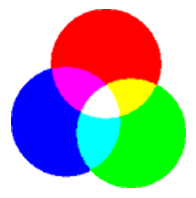| |
Color
Systems - Primary Colors
There
are actually two color systems: one which deals with emitted light
and one which deals with reflected light. A luminous source produces
light; illuminance is reflected light. A computer monitor is a self-luminous
source because it emits light. Your keyboard, mouse, and desktop
are reflecting light from a luminous source in your environment.
They are being illuminated by a lamp, ceiling fixtures, or sunlight.
If your keyboard or mouse has an LED, the LED is a luminous source
because it emits light.
All
of the colors of light that we perceive can be produced by combinations
of the three primary colors: Red, Green, and Blue. However, how
these colors mix depends on whether we are dealing with emitted
luminance or reflected light. These two different color systems
are referred to as: additive and subtractive, respectively.
- Additive
- pertains to self-luminous light sources. Mixing equal amounts
of red, green, and blue light produces "white" light.
The absence light creates "black."
- Subtractive
- pertains to an illuminated object that reflect lights, but does
not produce its own. The color we see is the color reflected from
the object; the colors we do not see are absorbed by the object.
"Black" is the absorption of all colors, that is, the
mixture of all colors. "White" is the reflection of
all colors.
This
course will primarily address additive color as it pertains to computer
monitors and self-luminous displays.
| Additive
Color |
Subtractive
Color |
 |
|
Applies
to Light Sources
Computer
Monitors
Emitted
Light
|
Applies
to Reflected Light
Printed
Images
Pigments & Paint
|
|
|










